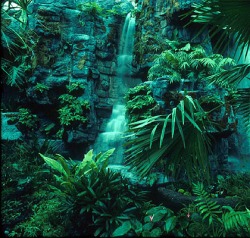Ecology
ENERGY FLOW THROUGHOUT THE TROPICAL RAINFOREST:
The transformations of energy in a tropical rainforest starts when the energy with the sun. Energy from the sun is captured by plants through photosynthesis, this process is called the trophic level toward the food chain if their were none of this the food chain wouldn’t work, because it’s the first step in the process of energy relations to living things it’s called the Primary Production.
The next step in the process involves Herbivores.
Herbivores eat the plants, collecting the energy to serve their needs.
Herbivores are Primary Consumers.
Carnivores eat Herbivores and Detritivores, Carnivores are Secondary Consumers, meaning that they are next on the food chain; they eat meat and only meat. Detritivores are scavengers and are called Tertiary Consumers, they’ll eat any left over food, dead or alive, and they’ll even eat other animal or plants wastes.
Any left over bone or meat then decomposes and fertilises the ground which then helps other plants grow.
Energy that travel through the food chain is inefficient, this meaning that the less energy or sunlight that gets through to the plants, then less energy for the herbivores to consume, than less for the carnivores and omnivores, making it harder for the Detritivores to stay alive and other mentioned.
WHERE TROPICAL RAINFORESTS ARE FOUND:
Tropical rainforests are found in a band around the equator. Temperatures at the equator are high. These high temperatures cause faster evaporation of water, which results in a lot rain fall and humidity. They only have two main seasons in a tropical rainforest, the wet season and the dry season.
The average rainfall in a tropical rainforest per month would be around ninety millilitres.
Tropical rainforests are found in locations such as:
- Central America
- West Africa
- Eastern Madagascar
- Indonesia
- Malaysia
- West Coast of India
- Papua New Guinea
- USA
- Congo
- Australia
VARIOUS MUTUALISTIC RELATIONSHIPS WITHIN THE TROPICAL RAINFOREST:
A mutualism is a relationship where both species help each other live or live as one.
This way it’s easier to navigate a predator, or look for prey.
The species involved are called symbionts. In commensalism (a relationship between two different organisms) one provides nutrients, shelter and support for the other.
An example of this would be a bird that eats bugs out of the eyelashes of rhinoceros. In this situation the bird gains food, and it’s also an advantage to the rhinoceros having its eyes cleaned.
This is just a minor example, only on the island of Sumatra, Indonesia, a rhinoceros can be found.
THE ABIOTIC AND BIOTIC FACTORS THAT AFFECT THE TROPICAL RAINFOREST:
Biotic: Means all living organisms within a community, they are divided up into groups depending on their function.
The groups are primary producers which all gain their energy and food through photosynthesis.
Next are the primary consumers, secondary consumers, tertiary consumers and decomposers.
Abiotic: Means all non-living organisms within a community that are divided up into groups depending on their function.
The Abiotic components include the seasonal climate, water, rain, lakes, rocks/bedrocks and much more.
Tropical forests are one of the most precious and threatened natural habitat, they need to have both components to survive.


